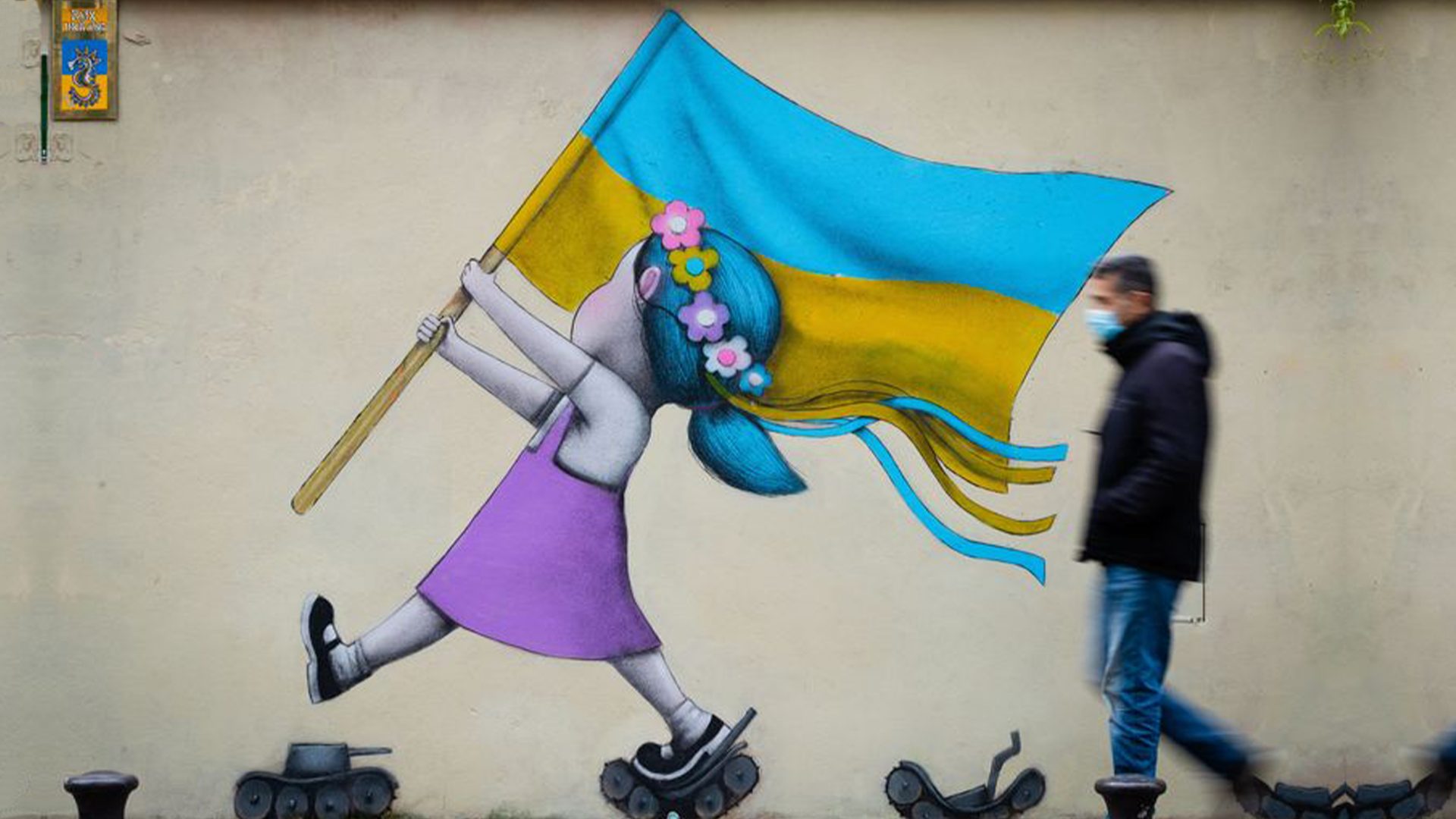In 2006, the fictional editor-in-chief Miranda Priestly turned her nose up at the mere suggestion of “florals for spring”. Luckily for the poor staffer who dared to suggest it, it didn’t quite earn the infamous pursing of her lips, a facial expression that equated to one thing – “disaster”.
“Loosely” inspired by Lauren Weisberger’s novel about her stint as assistant to the legendary Vogue editor Anna Wintour, The Devil Wears Prada had one foot in cinema and the other in reality. But this season, the fashion industry is being dominated by a trend with both feet firmly planted in the real world. “Florals for spring” are out, blue and yellow are in.
It started, as it so often does, out on the streets. In normal times, all eyes are on the runway during the Milan and Paris fashion weeks to see what styles the hottest designers had lined up. This time around, the focus was outside as street style became the chosen medium to show support for Ukraine.
2022 was supposed to mark Ukrainian style blogger Poly Kyrychenko’s first Milan fashion week, and it did – but not in the way she anticipated. On day two, she was awoken at 5am by calls from relatives that her country was being invaded. Later that day she was photographed outside the Max Mara show clutching a cardboard sign with “No War in Ukraine” written on it, tears in her eyes. Then, outside the Prada show, she noticed more people doing the same. One proceeded to take their place inside holding a shopping bag with the same message scrawled on it.
Georgio Armani found his voice and took a stand, just in silence. Out of respect for the suffering in Ukraine, his models walked up and down the catwalk to no music. The designer released a statement on his social media explaining that this was to reflect the “ongoing tragedy”.
In Paris, what began with cardboard then evolved into blue and yellow fabric. At the Balenciaga show, each attendee was met with a folded blue and yellow T-shirt on their seats. Celebrities arriving in the same colour scheme had clearly got the memo. The actress Salma Hayek wore a half yellow, half blue tunic, and the designer Isabel Marant received praise for her attire of a yellow and blue sweatshirt.
American designer Christian Siriano joined the effort by crafting a custom-made blue and yellow tulle criss-cross gown. His masterpiece, fashioned in the colours of the Ukrainian flag, is to be auctioned off to the highest bidder, with the winning amount being matched in donations to the country.
“If a few bolts of tulle can help save someone then YES, we will be donating this gown to the highest bidder possible and matching that donation for Ukraine,” wrote the Project Runway winner on his Instagram page, before adding an email address where bids can be made. On his social media, admirers have commented that they only hope it isn’t long before such a design is on the red carpet. Greta Lee was way ahead of them.
At the Screen Actors Guild awards last month, the actress arrived in a blue skirt paired with a yellow polo-neck top with cut-out side panels. Tyler Perry, Michael Douglas and Shari Belafonte in turn all wore pocket squares and ribbons featuring the colours. But is donning blue and yellow in solidarity purely symbolic?
Ukrainian designer Anna October, now in Paris, has mixed feelings on the trend. She didn’t deny the help nor the awareness this so-called snazzy solidarity can bring, but believes more needs to be done by the industry’s big names.
Enter Daria Shapovalova and Natalia Modenova, Ukrainian co-founders of the digital clothing retailer DressX, who echo this sentiment. “When cities get shelled and civilians killed everyday, there is no ‘neutral position’,” they said. “You either stand for the truth or support the war.” In their war effort, however, fashion comes face to face with technology.
On the first day of the invasion, the co-founders started the Support Ukraine Initiative. This kickstarted a collection as a way of launching a donation campaign to support those in Ukraine. Proceeds go towards the Ukrainian Ministry of Defence, 3D fashion designers who have lost their homes, computers and jobs, and charities that support Ukraine, including the Return Alive Foundation. They sign off their initiative online with the rally cry #fashionforpeace.
They have also created a range of AR (augmented reality) filters including a bucket hat with “Act Now” written across it, a sweatshirt stating “I stand with Ukraine”, a heart-shaped dress and a pair of heart earrings, each in blue and yellow, all for users to share on social media in exchange for a donation to a charity helping Ukraine. It has been supported by the Queen of Pop herself, Madonna, and to date has raised over $18,000 (£13,650) for Ukraine.
Other Ukrainian designers, however, have been forced to swap the symbolic for the practical. In Warsaw, a group of Ukrainian seamstresses who fled the country are hard at work. By day, they sew wedding dresses, but by night they craft camouflage outfits for the soldiers back home. Marta Trojanowska, the owner of Suknie Bridal, showed off a cape she and her team constructed to the BBC. They are fashioned out of old coffee sacks, hundreds of kilos of which have now been donated.
The capes are designed to help soldiers blend into their surroundings, covering their arms, shoulders and heads. “A military man came to advise us,” one seamstress explained. “He showed us how to make these correctly so the cape can offer real protection.”
Practicality aside, blue and yellow have become the colours of the cause and while some may be sceptical about the impact clothing can have, fashion has long been a tool of political protest and change.
In the early 20th century, suffragettes adopted a uniform of white, purple and green; colours to symbolise purity, dignity and hope in their fight to achieve the right to vote. One rock star of the movement, Flora Drummond, even took to wearing a military-style uniform in these colours, earning her the nickname “the general”.
In Nazi-occupied Paris, couture houses were forced to close with the aim of economically and culturally hurting France. In protest, wealthier women secretly commissioned the houses to make clothes for them. They would be plain and simple in appearance to hide signature designs, but while the women wore the items they knew the craftsmanship of French couture lived on under the noses of the Nazis. It was protest at its most witty, audacious and, well, French.
In recent years, global fashion brands have used the pandemic as their foothold into political dressing. Valentino designed a hoodie that stamped the word “vaccinated” where the logo would usually sit to take a seat at the table of the anti-vaxxer debate.
Naturally, we all remember Alexandria Ocasio-Cortez’s “Tax the Rich” dress she wore to the Met Gala last year, an event that usually hosts the ideal audience open to a debate about overhauling the US tax system. Where there is politics, fashion seems to be lurking around the corner – and vice versa. To echo the tone of the fictional publishing legend Priestly herself, maybe it’s “comical” to assume fashion could exclude itself from the political realm.
Andy Sachs couldn’t see it. She found herself snorting at two shades of blue, or rather, at the suggestion that two similar shades of light blue were “just so different”. It’s a snigger that prompted The Devil Wears Prada’s iconic “it’s actually cerulean” monologue takedown. How dare Sachs not know the history of the blue jumper she chose to wear that morning?
The blue on the Ukrainian flag is no stranger to such a history. After a somewhat short-lived revolution in 1917 the bicolour was chosen to symbolise a field of wheat under a blue sky for the Ukrainian People’s Republic, with the yellow lower band originating from the flag of the Austrian Empire, which had previously controlled Ukraine. Two years later the Soviets invaded and the colour red dominated the years of Soviet rule. In 1992, a year after Ukraine’s independence, blue and yellow were back. And now, the country’s two colours are everywhere – this year, blue and yellow are the new black.











